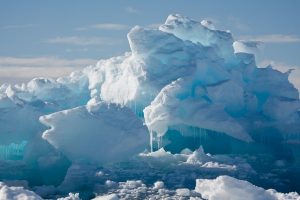A one trillion-ton iceberg – one of the largest ever recorded – has calved away from the Larsen C Ice Shelf in Antarctica. The final breakthrough was detected in data from NASA’s Aqua MODIS satellite instrument, which uses infrared thermal imaging at a resolution of 1km, and confirmed by NASA’s Suomi VIIRS instrument.
The calving took place sometime between Monday, July 10th and Wednesday, July 12th, 2017. The iceberg will most likely be named A68. Its volume is twice that of Lake Erie, and is the size of the state of Delaware.
The Larsen Ice Shelf is a long ice shelf in the northwest part of the Weddell Sea, extending along the east coast of the Antarctic Peninsula from Cape Longing to the area just southward of Hearst Island. In 2005, it covered approximately 78500 km2 of the earth’s sea with exce ptionally thick ice. It is named for Captain Carl Anton Larsen, the master of the Norwegian whaling vessel Jason, who sailed along the ice front as far as 68°10′ South during December 1893. In finer detail, the Larsen Ice Shelf is a series of shelves that occupy (or occupied) distinct embayment’s along the coast. From north to south, the segments are called Larsen A (the smallest), Larsen B, and Larsen C (the largest) by researchers who work in the area. Further south, Larsen D and the much smaller Larsen E, F and G are also named.
ptionally thick ice. It is named for Captain Carl Anton Larsen, the master of the Norwegian whaling vessel Jason, who sailed along the ice front as far as 68°10′ South during December 1893. In finer detail, the Larsen Ice Shelf is a series of shelves that occupy (or occupied) distinct embayment’s along the coast. From north to south, the segments are called Larsen A (the smallest), Larsen B, and Larsen C (the largest) by researchers who work in the area. Further south, Larsen D and the much smaller Larsen E, F and G are also named.
The development of the rift over the last year was monitored using data from the European Space Agency Sentinel-1 satellites – part of the European Copernicus Space Component. Sentinel-1 is a radar imaging system capable of acquiring images regardless of cloud cover, and throughout the current winter period of polar darkness.
Infrared thermography (IRT), thermal imaging, and thermal video are examples of infrared imaging science. Thermographic cameras usually detect radiation in the long-infrared range of the electromagnetic spectrum (roughly 9,000–14,000 nanometers or 9–14 µm) and produce images of that radiation, called thermograms.
Infrared thermal imaging is used in many other disciplines. Firefighters use them to see through smoke, find people and localize hotspots of fires. Law enforcement uses the technology to manage surveillance activities, locate and apprehend suspects, investigate crime scenes and conduct search and rescue operations. Power line maintenance technicians locate overheating joints and parts to eliminate potential failures. Where thermal insulation becomes faulty, building construction technicians can see heat leaks to improve the efficiencies of cooling or heating.
Universe Kogaku designs and manufactures optical lenses for security, high tech and electronic applications. We stock 1000’s of standard lens assemblies and can custom design a solution for scanners, CCTV, CCD/CMOS, medical imaging, surveillance systems, machine vision and night vision systems.